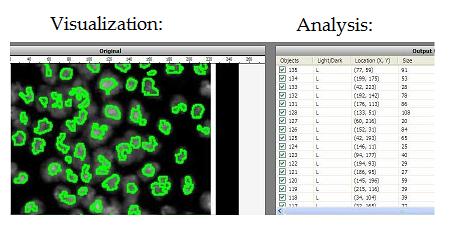Fields related to Computer Vision, part 3
Here I finish (part 1 and part 2) my short review of Quantitative Biological Image Analysis by Erik Meijering and Gert van Cappellen.
The last two items on the list of fields are the following.
Computer Graphics: numbers in -> image out. Instead of numbers one could have math functions that produce numerical descriptions of images. These descriptions are likely to be different from those in computer vision: vector vs. raster images (the difference is in fact superficial from the point of view of cell decomposition). It’s also “the inverse of image analysis”. That would seem to imply that if you use Image Analysis followed by Computer Graphics you’ll end up with the original image. That would make sense only if the data produced by image analysis does not go very deep (not image segmentation or Fourier transform etc). I think that Computer Graphics is simply irrelevant for Computer Vision.
Visualization: image in -> representation out. The idea is that high dimensional image data is transformed into a more primitive representation. Displaying contours of objects is an example of that, illustrated below with Pixcavator. “Pseudocoloring” is an interesting subtopic here even though it can be also classified as image processing.

In conclusion, a couple of quotes from the article. In spite of the disagreement, I am glad that there are people thinking about these issues.
Although it is certainly possible to categorize problems, in a sense each biological study is unique: being based on specific premises and hypotheses to be tested, giving rise to unique image data to be analyzed, and requiring dedicated image analysis methods in order to take full advantage of this data.
It seems to me that there is nothing here that would make these fields/methods/problems limited to biological applications (or medical).
All too often, scientific publications report the use of image analysis tools without specifying which algorithms were involved and how parameters were set, making it very difficult for others to reproduce or compare results.
I think it is the common attitude presented in the first quote that causes this problem. The solution is obvious:
Most of image analysis should be context independent.
In other words, it should be mathematical. Once mathematical issues are understood, image analysis becomes a tool, like a calculator or spreadsheet software.
P.S. I’ll try to rewrite the list and put it in the wiki under Fields related to Computer Vision.
Top finds
- Casinos Not On Gamstop
- Non Gamstop Casinos
- Casino Not On Gamstop
- Casino Not On Gamstop
- Non Gamstop Casinos UK
- Casino Sites Not On Gamstop
- Siti Non Aams
- Casino Online Non Aams
- Non Gamstop Casinos UK
- UK Casino Not On Gamstop
- Non Gamstop Casino UK
- UK Casinos Not On Gamstop
- UK Casino Not On Gamstop
- Non Gamstop Casino UK
- Non Gamstop Casinos
- Non Gamstop Casino Sites UK
- Best Non Gamstop Casinos
- Casino Sites Not On Gamstop
- Casino En Ligne Fiable
- UK Online Casinos Not On Gamstop
- Online Betting Sites UK
- Meilleur Site Casino En Ligne
- Migliori Casino Non Aams
- Best Non Gamstop Casino
- Crypto Casinos
- Casino En Ligne Belgique Liste
- Meilleur Site Casino En Ligne Belgique
- Bookmaker Non Aams
- カジノ ライブ
- онлайн казино с хорошей отдачей
- スマホ カジノ 稼ぐ
- ブック メーカー オッズ
- Trang Web Cá độ Bóng đá Của Việt Nam
- Casino En Ligne Avis
- Casino En Ligne France













